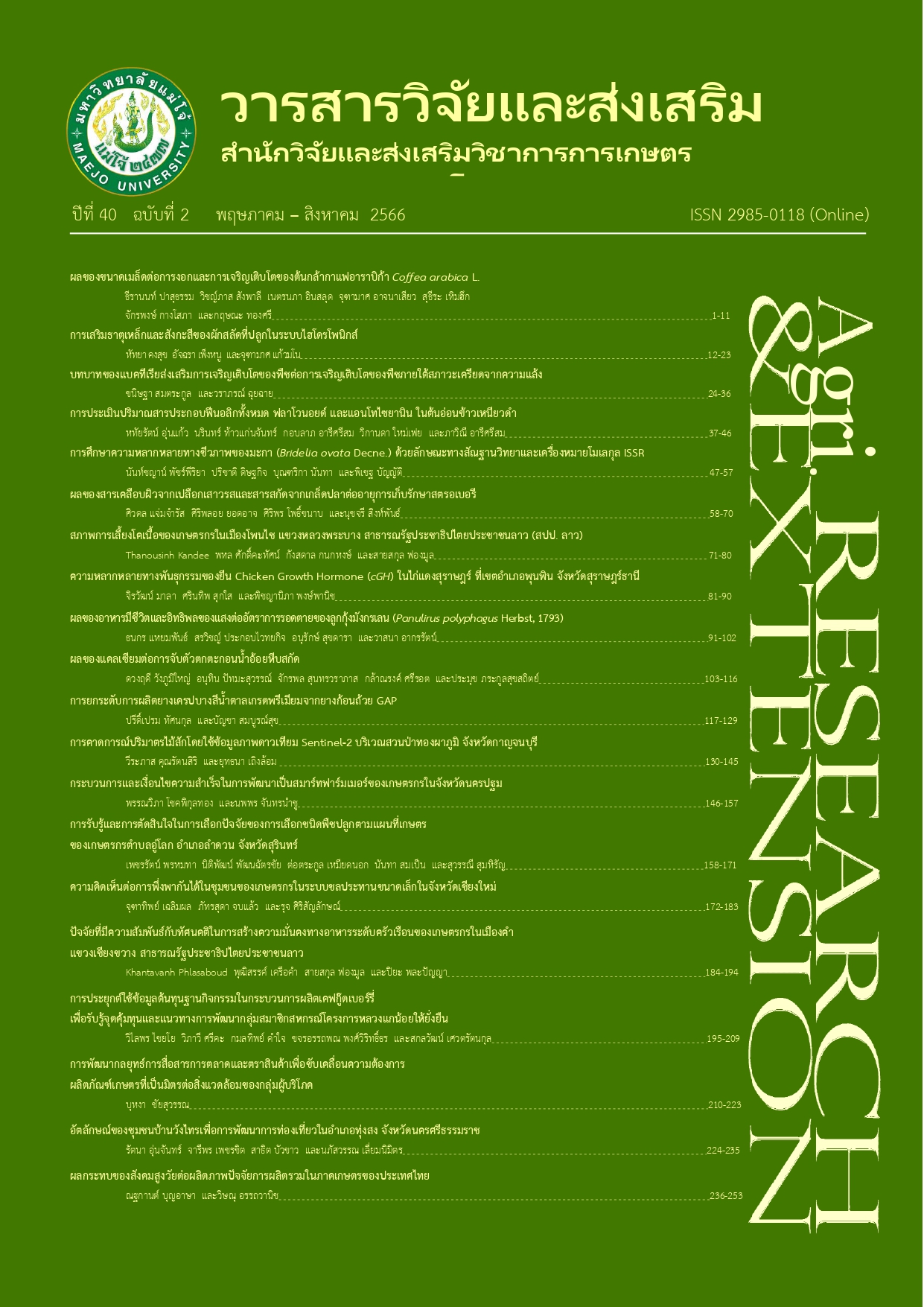การศึกษาความหลากหลายทางชีวภาพของมะกา (Bridelia ovata Decne.) ด้วยลักษณะทางสัณฐานวิทยาและเครื่องหมายโมเลกุล ISSR
คำสำคัญ:
มะกา , Brideria odata Decne, เครื่องหมายโมเลกุลชนิด ISSR , ความหลากหลายทางพันธุกรรมบทคัดย่อ
มะกา (Makaa, Bridelia ovata Decne.) จัดอยู่ในวงศ์ ยางพารา (Euphorbiaceae) ในสกุล Bridelia ที่มีความหลากหลายกว่า 60 สปีชีส์ ในบริเวณแอฟริกาและเอเชีย รวมถึงประเทศไทย ในมะกาพบว่ามีสารสำคัญหลายชนิดได้แก่ Friedelin stigmasterol β-sitosterol และ Campesterol ที่มีฤทธิ์ช่วยแก้อักเสบ รวมถึงยับยั้งเซลล์มะเร็งในระดับห้องทดลอง วัตถุประสงค์การทดลองในครั้งนี้เพื่อศึกษาทางสัณฐานวิทยาและความสัมพันธ์ทางพันธุกรรมของมะกาในประเทศไทย ทำการเก็บตัวอย่างมะกา 101 ต้น จาก 20 จังหวัดในประเทศไทย ทำการตรวจวัดลักษณะทางสัณฐานวิทยา ได้แก่ ความกว้าง ความยาว อัตราส่วนระหว่างความกว้างและความยาว และจำนวนเส้นใบของมะกา ทำการตรวจสอบลักษณะทางพันธุกรรมด้วยเครื่องหมายโมเลกุลชนิด ISSR ทั้งหมด 96 ไพรเมอร์ พบ 12 ไพรเมอร์ ที่ให้ความแตกต่าง ในประชากรมะกา ทำการคำนวณค่า Polymorphism information indexes เฉลี่ยเท่ากับ 0.31 การสร้างแผนภูมิของข้อมูลทางสัณฐานวิทยาด้วยโปรแกรม MEGA 7.0 วิธีการ UPGMA พบว่าไม่สามารถจับกลุ่มตัวอย่างตามภูมิภาคหรือจังหวัดได้ ในส่วนของการสร้างแผนภูมิของข้อมูลทางพันธุกรรมด้วยวิธีการ Neighbor-joining พบว่าไม่สามารถแบ่งกลุ่มตัวอย่างตามภูมิภาคได้อย่างชัดเจน แต่สามารถใช้จัดกลุ่มจากเขตจังหวัดและเขตพื้นที่จังหวัดใกล้เคียงได้
เอกสารอ้างอิง
Bua-in, S. 2009. Genetic Diversity, Active Compounds and Antioxidant Activity in Zingiber montanum (Koening) Link ex Dietr, and Its Relatives. Master Thesis. Kasetsart University. 99 p. [in Thai]
Chayamarit, K. and P.C. van. Welzen. 2005. Flora of Thailand: Euphorbiaceae (Genera A-F). Bangkok: The Forest Herbarium, National Park Wildlife and Plant Conservation Department, Thailand. 303 p.
Evanno, G., S. Regnaut and J.Goudet. 2005. Detecting the number of clusters of individuals using the software STRUCTURE: a simulation study. Molecular Ecology 14(8): 2611-2620.
Godwin, I.D., E.A.B. Aitken and L.W. Smith. 1997. Application of inter simple sequence repeat (ISSR) markers to plant genetics. ELECTROPHORESIS 18(9): 1524-1528. [Online]. Available https://doi.org/10.1002/elps.1150180906 (April 12, 2023).
Khunpiban, A. 2010. Genetic Diversity of Edible Galanga (Alpinia spp.) in Thailand Using AFLP Technique. Master Thesis. Kasetsart University. 86 p. [in Thai]
Kumar, S., G. Stecher and K. Tamura. 2016. MEGA7: molecular evolutionary genetics analysis version 7.0 for bigger datasets. Molecular Biology and Evolution 33(7): 1870-1874.
Laosatit, K. 2010. Genetic diversity of Waan Chak Modlook (Curcuma sp.) in Thailand Revealed by Amplified Fragment Length Polymorphism (AFLP). Master Thesis. Kasetsart University. 103 p. [in Thai]
Ngueyem, T.A., G. Brusotti, G. Caccialanza and P.V. Finzi. 2009. The genus Bridelia: a phytochemical and ethnopharmacological review. Journal of Ethnopharmacology 124(3): 339-349. [Online]. Available https://doi.org/10.1016/j.jep.2009.05.019 (April 12, 2023).
Ng, W. and S. Tan 2015. Inter-simple sequence repeat (ISSR) markers: are we doing it right. ASM Sci J. 9(1): 30-39.
Pandotra, P., A.P. Gupta, M.K. Husain. and S. Gupta. 2013. Evaluation of genetic diversity and chemical profile of ginger cultivars in North-Western Himalayas. Biochemical Systematics and Ecology 48: 281-287.
Poofery, J., P. Khaw-On, S. Subhawa, B. Sripanidkulchai, A.Tantraworasin, S. Saeteng, S. Siwachat, N. Lertprasertsuke and R. Banjerdpongchai 2020. Potential of Thai herbal extracts on lung cancer treatment by inducing apoptosis and synergizing chemotherapy. Molecules 25(1): 1-30. DOI: 10.3390/molecules 25010231.
Pradeep Reddy, M., N. Sarla and E. Siddiq. 2002. Inter simple sequence repeat (ISSR) polymorphism and its application in plant breeding. Euphytica 128: 9-17.
Pritchard, J.K., M. Stephens and P. Donnelly. 2000. Inference of population structure using multilocus genotype data. Genetics 155(2): 945-959.
Raji, R., and E.A. Siril. 2021. Genetic diversity analysis of promising ceylon olive (Elaeocarpus serratus L.) genotypes using morphological traits and ISSR markers. Current Plant Biology 26: 1-11. DOI:10.1016/j.cpb.2021.100201.
Thaikert, R. 2009. Genetic Diversity and some Active Compounds of Turmeric (Curcuma longa L.). Master Thesis. Kasetsart University. 73 p. [in Thai]
Thongkon, N. 1995. Chemical Constituents of the Leaves of Bridelia ovata Decne. Master Thesis. Chulalongkorn University. 75 p.
Wutthummawej, W. 2011. Enclycopedia of Pharmacutical in Ratthanakosin Era. Bangkok: Siam Art Package and Press. 720 p.
Yeboah, G.N., F.W.A. Owusu, M.-A. Archer, M.O. Kyene, D. Kumadoh, F. Ayertey, S.O. Mintah, P.A.-A. Junior and A.A. Appiah. 2022. Bridelia ferruginea Benth.: an ethnomedicinal, phytochemical, pharmacological and toxicological review. Heliyon 8: 1-18. DOI: 10.1016/j.heliyon.2022.e10366.
Yousefi, V., A. Najaphy, A. Zebarjadi and H. Safari. 2015. Molecular characterization of Thymus species using ISSR markers. JAPS: Journal of Animal & Plant Sciences 25(4): 1087-1094.
ดาวน์โหลด
เผยแพร่แล้ว
รูปแบบการอ้างอิง
ฉบับ
ประเภทบทความ
สัญญาอนุญาต
ลิขสิทธิ์ (c) 2023 วารสารวิจัยและส่งเสริมวิชาการเกษตร

อนุญาตภายใต้เงื่อนไข Creative Commons Attribution-NonCommercial-NoDerivatives 4.0 International License.
บทความนี้ได้รับการเผยแพร่ภายใต้สัญญาอนุญาต Creative Commons Attribution-NonCommercial-NoDerivatives 4.0 International (CC BY-NC-ND 4.0) ซึ่งอนุญาตให้ผู้อื่นสามารถแชร์บทความได้โดยให้เครดิตผู้เขียนและห้ามนำไปใช้เพื่อการค้าหรือดัดแปลง หากต้องการใช้งานซ้ำในลักษณะอื่น ๆ หรือการเผยแพร่ซ้ำ จำเป็นต้องได้รับอนุญาตจากวารสาร





